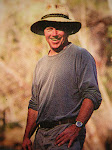I watched the tide come
in today. It was an unplanned entertainment; one minute I'm piloting my green-and-rust pickup and trailer-load of kayaks along Ozello Trail, a narrow thread of asphalt strung through a dozen small islands off Florida's west coast, the next, I'm standing on a level, rocky plain
watching the glistening edge of the Gulf of Mexico slithering around my toes.
It was late afternoon and
I was in the quiet coastal region known as the Suncoast Keys. Unlike
the Atlantic coast, where sloped beaches and a steady pulse of waves mask the
rising water line, tides here advance
quickly across the table-flat terrain. From a distance, the approaching water moves like a sliding
sheet of glass. But up close, we see it’s more complicated than that—and much
more interesting.Behind a dense tussock of saw grass I spotted a line of raccoon tracks. I stooped for a closer look. As I did, a thin veneer of sea water slipped up and quickly filled each track, one toe-print at a time. In a few minutes, these tracks along with traces of countless other life-defining moments in countless tiny lives will be washed away. Charybdis was exhaling and she holds her breath for no man.
---------------------------------------------------------------------
Ozello. Charybdis
inhales.
A glass-smooth sea
slowly transforms into a fractured, rocky plain. Networks of miniature streams
form on the freshly exposed rocks. The newborn rivulets are precocious; born
moving, slowly at first, but soon quickening into tiny torrents chasing the
retreating sea. As the water continues dropping, the channels get narrower and
faster. Finally, nothing remains but a labyrinth of cracks— tiny arroyos in a
flat-rock desert, awaiting the next flash-flood of life-giving water.
Cedar Key. Charybdis
exhales.
It’s an evening in springtime. Slivers of moonlight flash
like tiny comets across the water. As the sea creeps landward, a male horseshoe
crab becomes excited. He patrols the shallow water, swimming parallel to the
shore. Charybdis is nearing the end of her exhalation. A female crab makes her
way toward the beach. The alert male intercepts her and climbs onto her back. He
clasps her shell with special appendages. A hundred renditions of this passion
play are happening up and down the beach. Some females have as many as a half
dozen males in tow. Just above the highest tide, the female burrows into the
sand and lays eggs. At the same time, the males deposit their sperm onto her
eggs. For 550 million years, horseshoe crabs have felt the tug of the full moon
and the warmth of Charybdis breath.
Sam’s Bayou, Homosassa
River. Charybdis inhales.
The freshly exposed
rocks are covered with nutritious plankton—a banquet for many small species.
But, time is limited. This unique landscape with all its bounty will wash away
with the next tide. Denizens of this intertidal world must work fast. Fiddler
crabs emerge from chimneyed burrows and scramble across the mud eagerly sucking
plankton and leaving bb sized pellets of filtered sand in their wake. Their
journey across the sand is marked by a series of these piles of sand
pebbles—tiny cairns, marking the way for any who wish to follow.
Marineland.
Charybdis inhales
The sea recedes,
revealing a low shelf of dark, loamy rocks. They are random and yet there is
vague symmetry to their placement. What are they telling us? What geomancers
hand cast them and what did he see in them? He finds meaning in the arrangement
of the stones. Others decipher ancient glyphs in the stones themselves. The
rich, dark brown humus nearly reeks of the ancient forest. It is their winnowed
remains. Every frivolous bit was discarded; the water pressed from every cell.
Chlorophyll of a tree compressed into a molecule. Every animal and every living
thing reduced to their essence. Pressed, packaged and stored in the rock. Though
the geomancer did not cast them, he reads them well.
The goddess loves
her finery. She adorns herself with gifts brought by her lover Poseidon, god of
the sea. When they were young, Poseidon would impress Charybdis with his
craftsmanship, pounding beautiful sculptures from the only material at
hand—beach stone. As he aged, the sea became more complex. Multitudes of sea
creatures provided an endless selection of baubles and gifts to offer
Charybdis. Sea shells, starfish, sand dollars, urchins and beautifully formed
bits of bone and cartilage lay thick at her feet. Later still, as the land
became inhabited, the gifts brought by the sea grew to include exotic seeds and
woods from distant lands. Today, the sea is an old man. He still delivers gifts
to his beloved, but they reveal his declining health. Instead of shells and
bones and polished wood, he brings tacky trinkets, the cast-off of infidels,
wayward buoys, discarded traps, Styrofoam, chemicals, oil and assorted plastic
gimcrack from toy soldiers to oil drums. It hurts the sea to know he has little
to give but costume jewelry.
Ozello. Charybdis coughs
Nutrient rich
water seeps through the saw grass and laps against the rotting stumps of
recently dead palms. Tiny acorn barnacles hoist their feathery legs from
cone-shaped shells, seining the water for microscopic plankton. Like French
girls standing on the rubble, waving flags to their liberators, the barnacles
stand on the decaying remains of fallen trees and wave. They celebrate their
rescue from the desiccating sun, drinking deeply the returning nutrient water.
They know only the moment and think nothing of the carnage around them.
Fenholloway River.
Charybdis gasps
There is little
activity on the shores of this, a river long-since sacrificed to a pulp mill. A few hardy plants cling to the upper beach while a destitute
population of small animals rummage through the wreckage. They have little to
fear from otters or raccoons.
Charybdis sighs

1 comment:
Thanks again Lars.I don't have to imagine our world as a living breathin being, it is.
Your words help to immerse me in that world.
Post a Comment